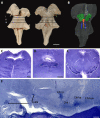Turning on the Light Within: Subcortical Nuclei of the Isodentritic Core and their Role in Alzheimer's Disease Pathogenesis
- PMID: 25720408
- PMCID: PMC4550582
- DOI: 10.3233/JAD-142682
Turning on the Light Within: Subcortical Nuclei of the Isodentritic Core and their Role in Alzheimer's Disease Pathogenesis
Abstract
Pharmacological interventions in Alzheimer's disease (AD) are likely to be more efficacious if administered early in the course of the disease, foregoing the spread of irreversible changes in the brain. Research findings underline an early vulnerability of the isodendritic core (IC) network to AD neurofibrillary lesions. The IC constitutes a phylogenetically conserved subcortical system including the locus coeruleus in pons, dorsal raphe nucleus, and substantia nigra in the midbrain, and nucleus basalis of Meynert in basal forebrain. Through their ascending projections to the cortex, the IC neurons regulate homeostasis and behavior by synthesizing aminergic and cholinergic neurotransmitters. Here we reviewed the evidence demonstrating that neurons of the IC system show neurofibrillary tangles in the earliest stages of AD, prior to cortical pathology, and how this involvement may explain pre-amnestic symptoms, including depression, agitation, and sleep disturbances in AD patients. In fact, clinical and animal studies show a significant reduction of AD cognitive and behavioral symptoms following replenishment of neurotransmitters associated with the IC network. Therefore, the IC network represents a unique candidate for viable therapeutic intervention and should become a high priority for research in AD.
Keywords: Aging; Alzheimer’s disease; brainstem nuclei; early diagnosis; human; monoamines; neurodegeneration; neurofibrillary tangles; neuromodulation; pathology.
Figures


References
-
- Sosa-Ortiz AL, Acosta-Castillo I, Prince MJ. Epidemiology of Dementias and Alzheimer's Disease. Arch Med Res. 2012;43:600–608. - PubMed
-
- Chan KY, Wang W, Wu JJ, Liu L, Theodoratou E, Car J, Middleton L, Russ TC, Deary IJ, Campbell H, Wang W, Rudan I. Epidemiology of Alzheimer's disease and other forms of dementia in China, 1990–2010: a systematic review and analysis. The Lancet. 2013;381:2016–2023. - PubMed
-
- Thies W, Bleiler L, Alzheimer's Association 2013 Alzheimer's disease facts and figures. Alzheimers Dement. 2013;9:208–245. - PubMed
-
- Duyckaerts C, Delatour B, Potier MC. Classification and basic pathology of Alzheimer disease. Acta Neuropathol. 2009;118:5–36. - PubMed
-
- Andrade-Moraes CH, Oliveira-Pinto AV, Castro-Fonseca E, da Silva CG, Guimaraes DM, Szczupak D, Parente-Bruno DR, Carvalho LR, Polichiso L, Gomes BV, Oliveira LM, Rodriguez RD, Leite RE, Ferretti-Rebustini RE, Jacob-Filho W, Pasqualucci CA, Grinberg LT, Lent R. Cell number changes in Alzheimer's disease relate to dementia, not to plaques and tangles. Brain. 2013;136:3738–3752. - PMC - PubMed

